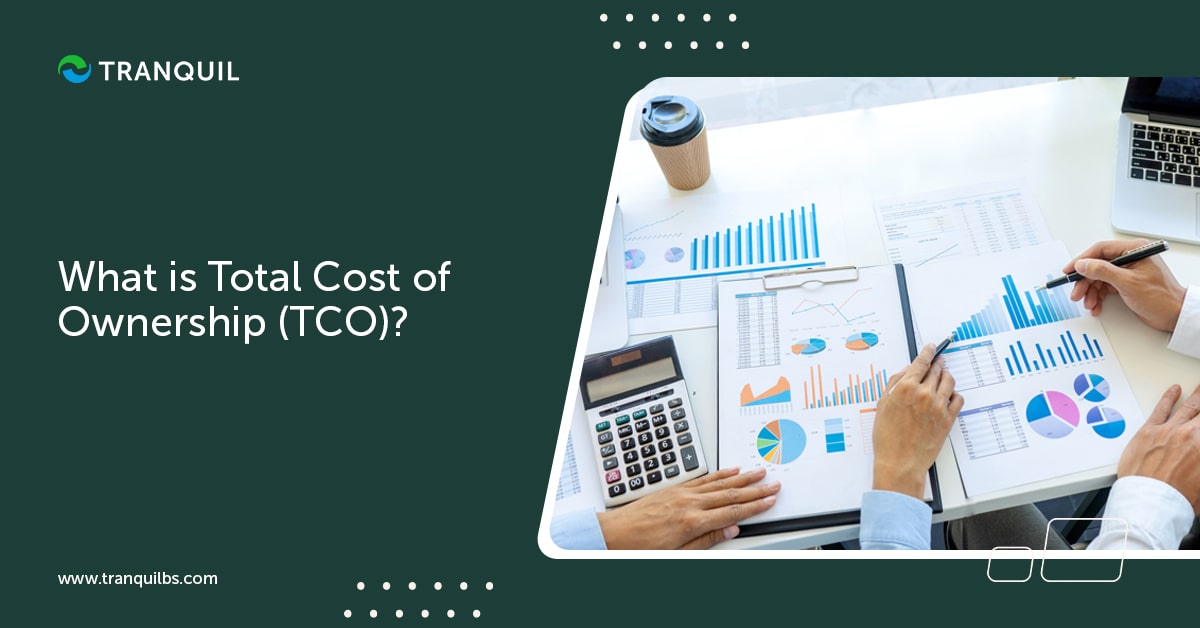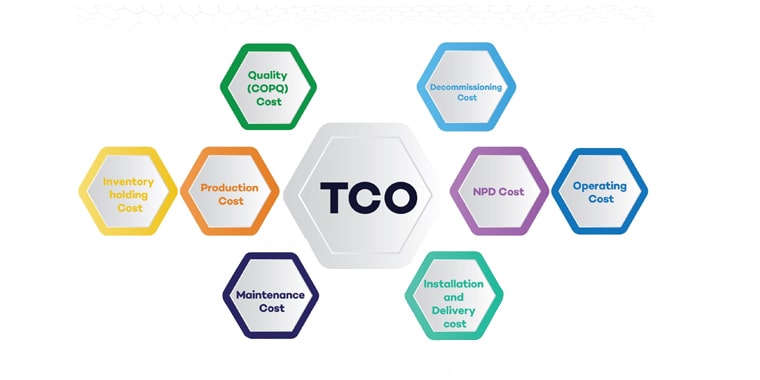
The total cost of ownership or TCO refers to the total cost of a product or service across its lifecycle.
It considers all direct as well as indirect costs.
It is an invaluable tool for decision-making, as it offers additional opportunity to create value through optimizing expenses and so on.
ALSO READ: How Do ERP and Cloud Computing Differ?
Though we can’t be certain, some experts opine that TCO originated in the early 19th century. Engineers assessed cannons for efficiency by analyzing their service life and what repairs were required.
In the late 1990s, the US Department of Defense formalized the approach as they were evaluating the overall expenditure associated with a specific program; eventually, they published a military standard.
Since that time, several companies in the industrial arena adopted this approach to have an accurate production cost calculation, and have a clearer picture about margins and selling prices.
ALSO READ: Guide on How Do ERP Systems Work
The goal of TCO is to calculate the complete cost of procuring a product or service from a particular vendor, beyond its basic purchase price.
We can define it as the total expenditure incurred in obtaining, utilizing, handling, and withdrawing an asset over its whole lifecycle.
Going by this, TCO brings all the expenses associated with a specific product or service across its entire lifecycle; not just the direct and obvious costs, but also indirect or unseen expenses.
You could say, in a way, that it is the total cost of investment you have made in that product or service.
To determine the TCO of any product or service, it is important to know how it is calculated.
ALSO READ: Warehouse Safety Checklist: Key Things to Inspect

There are several methods of calculating the TCO, and the method you use will depend on the specific type of product or service you want to calculate it for.
There is no one-size-fits-all solution for calculating TCO.
However, the components are more or less similar across industries.
There are about 8 types of expenses.
Let’s get to know them:
ALSO READ: Balance Sheet: Definition, Uses, Elements
If we look at company cars ownership, the calculation of TCO considers all the above-mentioned factors.
The cost incurred includes customs duties, transport costs, and so on.
Owning and using vehicles like these means you also have to pay taxes.
This has to be included in the calculation of TCO, and may differ from nation to nation.
You will also have to consider expenses like registration expenses, and possible penalties or bonuses based on environmental sustainability.
This means that the total cost incurred and the benefits derived from owning these vehicles must be compared meticulously, to determine if it is indeed beneficial to own the cars, or whether renting them would be more economical.
There is another way of looking at total cost – Total Value of Ownership.
This approach goes beyond merely looking at costs to make decisions, and to look at the beneficial returns of a product bought or service availed.
Factors like sustainability, risk control, growth, and so on are considered for calculating the benefits – quite similar to the TCO calculation.
ALSO READ: Accounting Problems and Solutions

Whenever a business is considering purchasing some assets or investing in certain capital projects, they look at the total cost of ownership.
Companies have the costs related to purchase and the costs related to operations and maintenance listed separately in their financial statements.
The first one – related to the purchase, is a capital expense, and the second is part of operating expenses. Analyzing the ownership cost in its totality, is commonly followed by most businesses.
Total cost of ownership is used by businesses in the long run as a basis to evaluate business deals.
Considering the TCO is a holistic approach, since it examines the purchase from a wider outlook.
The evaluation includes the purchase price paid initially, along with all direct and indirect expenditures.
It is easy to report direct expenses; however, businesses normally attempt to evaluate all the possible indirect expenses that could have a significant impact on influencing the purchase decision.
ALSO READ: Debit Notes vs Credit Notes
Let us go again take the example of owning a car; the cost comparison matters a lot here.
The total cost of owning a car is not merely the purchase price, but it also includes expenses that the owner has to incur because of use.
Examples are fuel, servicing expenses, spare parts, insurance, repairs, or any modifications or additions made.
The calculation of the total ownership cost is especially important when you are comparing a new car and a used car.
While the purchase cost of a used car is likely to be much lower than that of a new car, its total ownership cost could be much higher.
This is because, as an older car, it may be more susceptible to breakdowns and need more repairs; there will be some wear and tear, and you may need to frequently replace parts; it may not be as fuel-efficient as a new car too.
A new car on the other hand, often has warranties for several parts, so that even if any of it malfunctions, you could get free replacements.
Therefore, a meticulous calculation of the total cost of ownership must be made, and a thorough comparison made, before you make a decision on whether to buy a new car or used car.
ALSO READ: Route and Van Sales – Challenges and Opportunities

Today, numerous methods and software tools are available that help in calculating the total cost of ownership; however, the process is still not perfect, as most businesses are themselves not sure of which method they want to use.
This can be problematic, as purchase decisions cannot be formed on uniform information.
Further, determining the scope of operating expenses for IT equipment is extremely dicey.
There are often hidden costs that one tends to forget, like warranties and depreciation.
Sometimes, incomparable products are compared, and even that can create issues.
ALSO READ: Emerging Trends in Supply Chain Management
Let’s say that the support expenses on a server includes spare parts costs.
For another server, it only does not include spare parts.
Now a hasty comparison will make it seem that the first server costs more in terms of the support cost.
Analyzing ownership costs usually does not account for unforeseen spikes in the cost over the long term.
Like, the cost of the part that is upgraded has suddenly increased significantly more than what you expected, because your regular vendor did not have it for whatever reason, and you had to procure it from a new vendor.
The calculation of TCO cannot take into consideration factors like change in suppliers, upgrade and service availability, and so on.
If an equipment manufacturer doesn’t stock parts or discontinues a product, or a software vendor discontinues specific functionality or support for a software solution, your business may have to incur unforeseen substantial extra costs, pushing the total cost of ownership much higher than the initial estimate.
Corporate managers and those making the decisions regarding purchases, analyze costs of various options and then compare the total ownership costs, to check the cost in totality, and eventually, which alternative incurs the lowest cost in the long period.
The purchase price of a server or license fees for a software solution could be priced much lower than that of a popular or competing one.
Those in charge of purchase will determine how much it would cost to upgrade the server or software, check the cost of annual service contracts and so on to see whether these costs will have an impact on the savings in cost they expect to make.
For example, the TCO of a particular model could be higher than that of another model; however, the benefits it offers may be significantly higher than that of the competing model.
By not performing a TCO analysis, companies could end up with grossly miscalculated purchase budgets, or purchase equipment or vehicles that are not actually suited to their needs.
This could cause slow services, frequent maintenance, unprecedented downtime, and other issues.
ALSO READ: Inventory Management Trends to Know

Reducing total cost of ownership is something the decision-makers in procurement attempt to do, to create value for the company.
This is achieved by first calculating the TCO, which considers the elements we spoke about earlier.
The next step is optimization; when we talk about company cars, reducing the total cost of ownership could be related to implementing best practices to reduce fuel consumption and minimize wear and tear so that you don’t have to spend a lot for maintenance and servicing.
When we talk about IT equipment, it could be something like ensuring a dust-free environment to prevent spoilage, and so on.
ALSO READ: Understanding Sales Management in ERP
Knowing the TCO of a product or service offers several benefits like:
There is no doubt that calculating the TCO ensures better decision making, lower costs, and more profitability.
ALSO READ: ERP in Accounting and Financial Management
Tranquil ERP has the features and functionality that helps you automate and streamline the process of calculating TCO so that you can bring more efficiency into your operations and earn more revenues. If you’re unsure how this works, do book a FREE demo at a time of your convenience, and we are happy to walk you through our software, and answer any questions you may have.